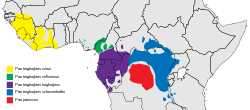
Back Pan (genus) Afrikaans Schimpansen ALS Pan (chenero) AN चिंपैंजी ANP شمبانزي Arabic شمبانزى ARZ Pan (animal) AST Zegol (Pan) AVK Şimpanze Azerbaijani شامپانزه AZB
| Chimpanzees and bonobos[1] | |
|---|---|

| |
| Members of the genus Pan: chimpanzee (left) and bonobo (right) | |
| Scientific classification | |
| Domain: | Eukaryota |
| Kingdom: | Animalia |
| Phylum: | Chordata |
| Class: | Mammalia |
| Order: | Primates |
| Suborder: | Haplorhini |
| Infraorder: | Simiiformes |
| Family: | Hominidae |
| Subfamily: | Homininae |
| Tribe: | Hominini |
| Subtribe: | Panina |
| Genus: | Pan Oken, 1816 |
| Type species | |
| Simia troglodytes Blumenbach, 1776
| |
| Species | |

| |
| Distribution of Pan troglodytes (common chimpanzee) and Pan paniscus (bonobo, in red) | |
| Synonyms | |
| |
The genus Pan consists of two extant species: the chimpanzee and the bonobo. Taxonomically, these two ape species are collectively termed panins,[3][4] however, both species are more commonly referred to collectively using the generalized term chimpanzees, or chimps. Together with humans, gorillas, and orangutans they are part of the family Hominidae (the great apes, or hominids). Native to sub-Saharan Africa, chimpanzees and bonobos are currently both found in the Congo jungle, while only the chimpanzee is also found further north in West Africa. Both species are listed as endangered on the IUCN Red List of Threatened Species, and in 2017 the Convention on Migratory Species selected the chimpanzee for special protection.[5]
- ^ Groves, C. P. (2005). Wilson, D. E.; Reeder, D. M. (eds.). Mammal Species of the World: A Taxonomic and Geographic Reference (3rd ed.). Baltimore: Johns Hopkins University Press. pp. 182–3. ISBN 0-801-88221-4. OCLC 62265494.
- ^ Wood, B.; et al. (2013). Wiley-Blackwell Encyclopedia of Human Evolution (paperback ed.). Wiley. ISBN 978-1-1186-5099-8.
- ^ Muehlenbein, M. P. (2015). Basics in Human Evolution. Elsevier Science. pp. 114–115. ISBN 9780128026526.
- ^ Diogo, R.; Molnar, J. L.; Wood, B. (2017). "Bonobo anatomy reveals stasis and mosaicism in chimpanzee evolution, and supports bonobos as the most appropriate extant model for the common ancestor of chimpanzees and humans". Scientific Reports. 7 (608): 608. Bibcode:2017NatSR...7..608D. doi:10.1038/s41598-017-00548-3. ISSN 2045-2322. PMC 5428693. PMID 28377592.
- ^ "Chimpanzees among 33 breeds selected for special protection". BBC. October 28, 2017. Retrieved October 30, 2017.
© MMXXIII Rich X Search. We shall prevail. All rights reserved. Rich X Search